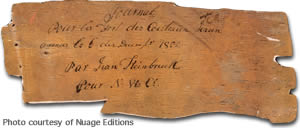|
Northern Vignettes
Arctic Harpoons
Beechey Island
Crystal II
Deline/Fort Franklin
Fort Hope
Fox Moth
Kellet's Storehouse
Naujan
Old Fort Providence
Old Fort Reliance
Stone Church
Thule Village
Yellowknife
Fort Journal
|
The Yellow Knife Fort Journal is an account, written in French, on pieces of birch bark. Jean Steinbruck, a voyageur and trader engaged by the North West Company, wrote this journal that introduces us to our early French Canadian fur trade heritage. The journal was written in 1802 when Steinbruck was posted at Yellow Knife Fort (MAP). Trade goods were late reaching the fort that year and, as a result, Steinbruck was left without many supplies, including paper. He used the birch bark from his canoe repair kit to keep a trading record of the post for the North West Company. This record dates from November to March 1802-03. The birch bark journal not only tells of the trading that took place at the fort, but also describes the daily routine of life at Yellow Knife Fort; the hardships, the activities of people living in the area, the animal life and the continual conflict with the NW Co.’s trading rival, the XY Company. For generations, the Canadian fur trade was based in Montreal and in an area around the Great Lakes known as the petit Nord. In the late 1700’s, traders extended the fur trade into the grand Nord, an area which now includes the NWT. Steinbruck was one of many French speaking traders who travelled west and north to be a part of this lively trade. Several trading companies competed for control of the fur trade at this time, the more well known being the Hudson’s Bay Company, the North West Company and the XY Company. The fur trade has left a lasting legacy in the Northwest Territories. Many of the fur traders were French Canadian and maps, place names, journals and family names reflect this French Canadian heritage. |
 In
March 2000, the Prince of Wales Northern Heritage Centre acquired
a rare historical document. Almost 200 years old, this document
offers a unique view of life at the first trading posts on the shores
of Great Slave Lake and the Mackenzie River.
In
March 2000, the Prince of Wales Northern Heritage Centre acquired
a rare historical document. Almost 200 years old, this document
offers a unique view of life at the first trading posts on the shores
of Great Slave Lake and the Mackenzie River.